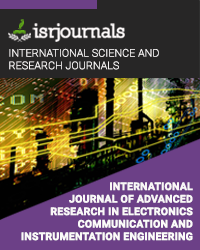proficient transmission of depth based routing and void-aware pressure routing for underwater sensor networks: review
S.Jessintha Gnana Kiruba,M. Navin Kumar
Published in International Journal of Advanced Research in Electronics, Communication & Instrumentation Engineering and Development
ISSN: 2347 -7210 Impact Factor:1.9 Volume:2 Issue:1 Year: 08 April,2014 Pages:12-18

Abstract
Underwater Acoustic Sensor Networks (UW-ASNs) have the potential to enable many applications such as environmental monitoring, undersea exploration and distributed tactical surveillance. Under water acoustic communication is preferred over Electromagnetic communication (radio and optical communication) due to higher propagation delay along with high attenuation of radio communication while the effect of scattering is higher at optical communication. Fundamental differences between underwater acoustic propagation and terrestrial radio propagation might need a new criterion for the design of networking protocols. Under water acoustic communication is difficult due to the fact of Energy consumption, delay and propagation speed along with node mobility in underwater environment. The prime objective is to find out a good performance metric considering the problems associated with the Depth Based Routing and to analyze Void Aware Pressure Routing using cross layer pair wise interconnection using enhanced beaconing and opportunistic data forwarding. Comparisons have been done through ns2 simulator with aquasim patch which shows that VAPR outperforms DBR in all aspects of productivity and responsiveness with Packet size.
Kewords
Depth Based Routing, Void Aware Pressure Routing, Local Maxima, Recovery node, Enhanced Beaconing
Reference
[1] Ian F. kyildi , ario ompili, ommaso Melodia”Underwater acoustic sensor networks: research challenges” Published by Elsevier Ad Hoc Networks Vol 3 (2005) pg 257–279. [2] J. Partan, J. Kurose, B.N. Levine, A survey of practical issues in underwater networks, in: Proceedings of ACM International Workshop on Underwater Networks (WUWNet), September 2006, pp. 17– 24. [3] M. ya , I. Baig, . bdullah, and I. Faye, “ sur ey on routing techniques in underwater wireless sensor networks,” ournal of International ournal of Distributed Sensor Networks 21 Network and Computer Applications, vol. 34, no. 6, pp. 1908– 1927, 2011. [4] I. F. kyildi , . ompili, and . Melodia, “ tate-of-the-art in protocol research for underwater acoustic sensor networks,” in Proceedings of the 1st ACM International Workshop onUnderwater Networks, pp. 7–16, September 2006. [5] H. Yan, Z. . . hi, and . H. ui, “ B : depth-based routing for underwater sensor networks,” in Proceedings of the 7th international IFIP-TC6 networking conference on AdHoc and sensor networks, wireless networks, next generation internet, vol.4982, pp. 72– 86, 2008. [6] G. Liu and Z. Li, “ epth-based multi-hop routing protocol for underwater sensor network,” in Proceedings of the 2nd International Conference on Industrial Mechatronics and Automation(ICIMA ’10), pp. 268–270, May 2010 [7] . Wahid and . Kim, “ n energy efficient locali ation- free routing protocol for underwater wireless sensor networks” International Journal of Distributed Sensor Networks, vol. 2012,Article ID 307246, 11 pages, 2012. [8] Youngtae Noh, Member, Uichin Lee, Paul Wang, Brian Sung Chul Choi, and Mario Gerla, “V : Void-Aware Pressure Routingfor Underwater Sensor Networks IEEE TRANSACTIONS ON MOBILE COMPUTING, VOL. 12, NO. 5, MAY 2013. [9] M. Zor i, . asari, Baldo and F. Harris III, ecember 2 “Energy-Efficient outing chemes for Underwater coustic etworks,” IEEE ournal on selected areas in Communications, Vol. 26, No. 9

